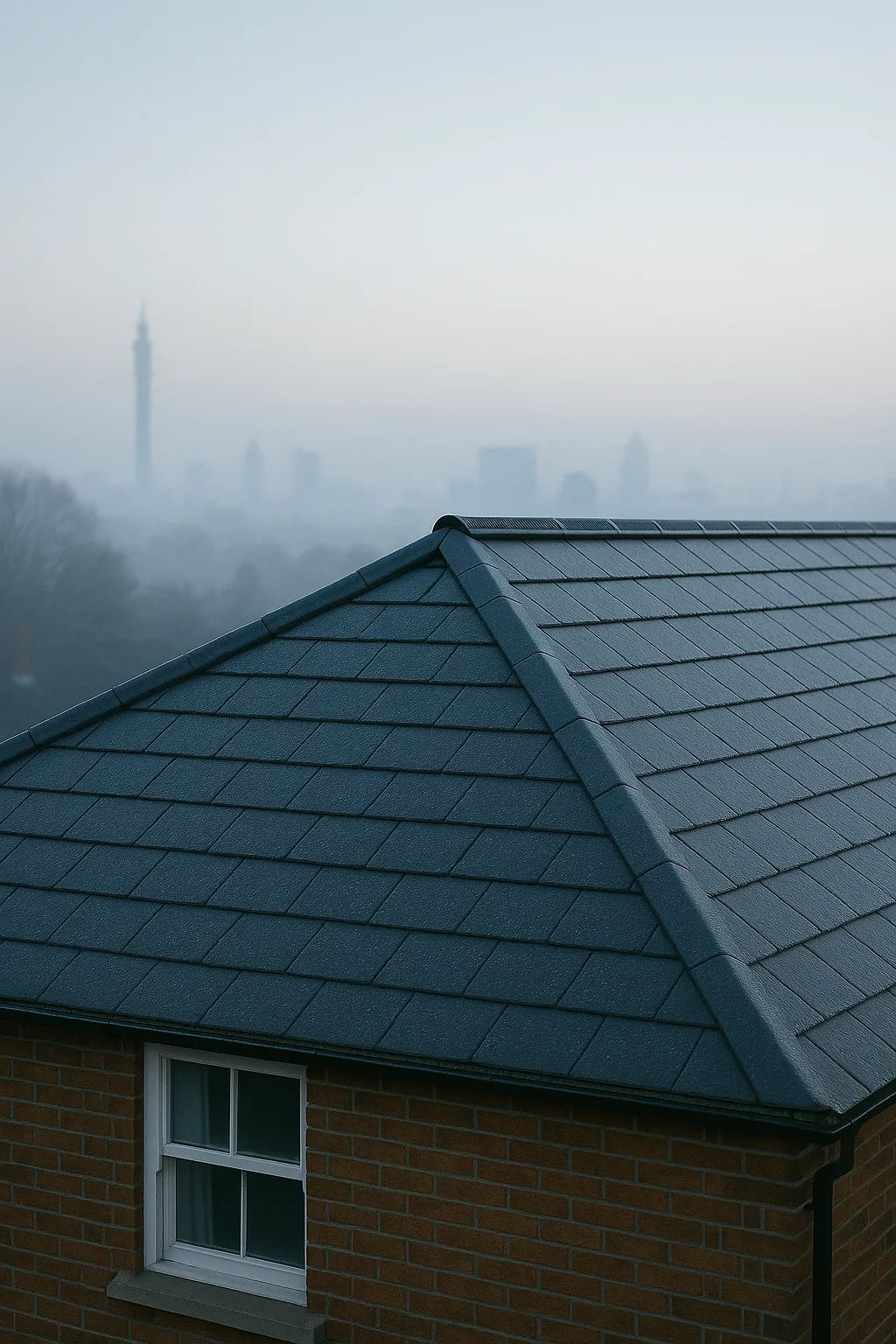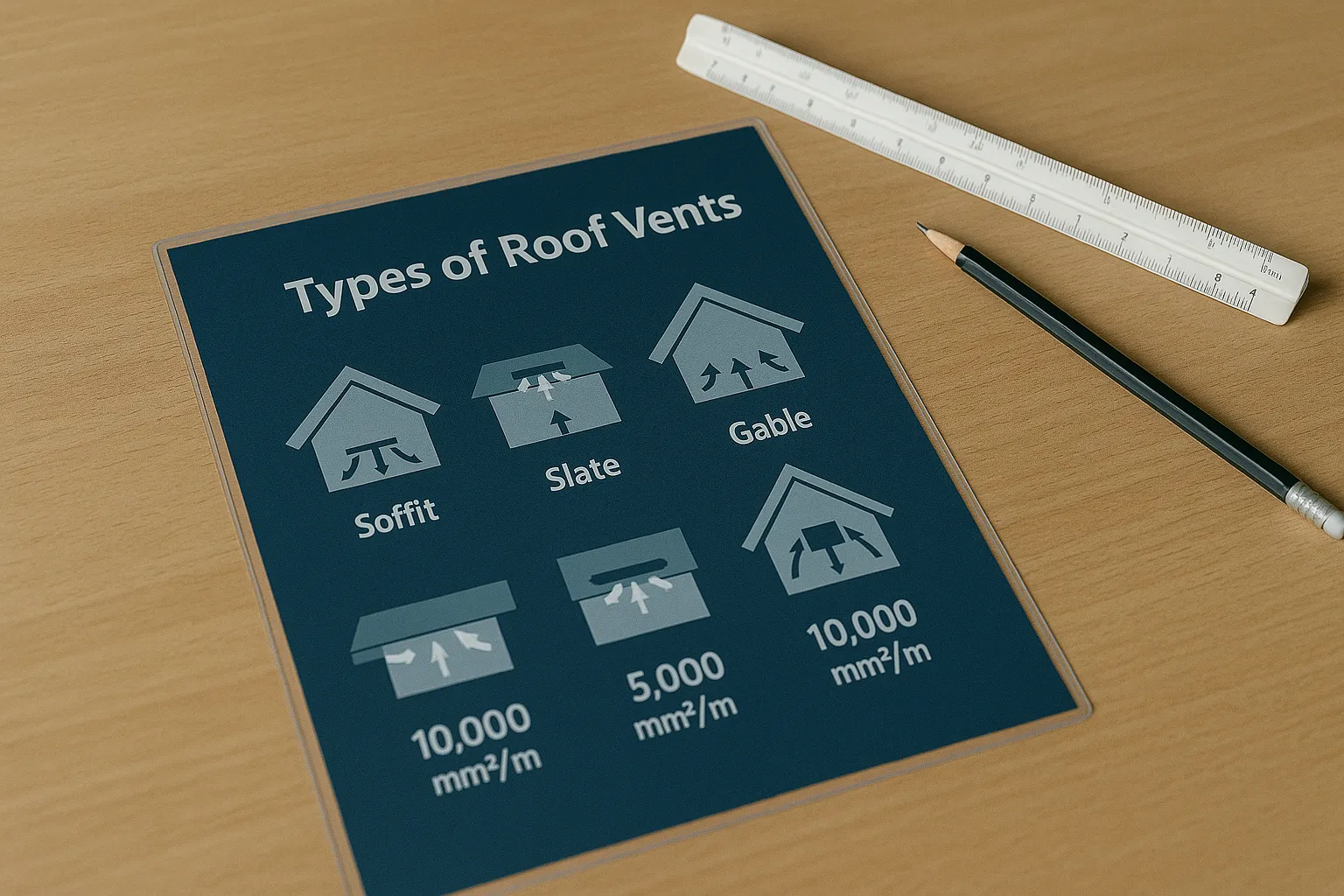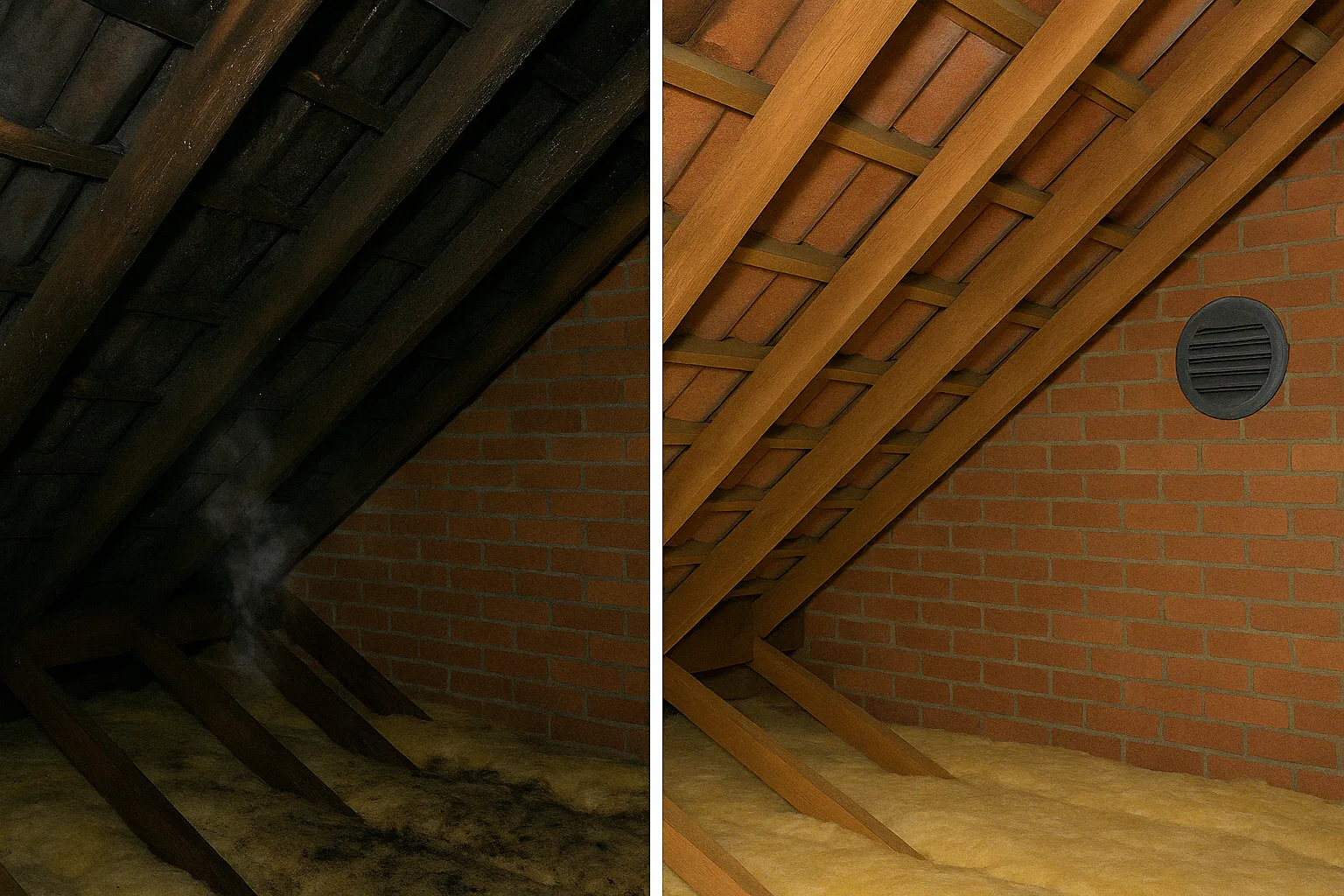Roof Ventilation Guide: Stop Condensation & Mould in Your Birmingham Loft

TL;DR: Birmingham's 85% winter humidity can cause serious loft condensation without proper ventilation. Install soffit and ridge vents (5,000 mm²/m required), check monthly with a £12 hygrometer, and budget £180-£450 for upgrades to prevent timber rot and mould damage.
Roof Ventilation Basics: How to Stop Condensation & Mould in Your Loft
Walking into your loft on a frosty Birmingham morning shouldn't feel like stepping into a rainforest. Yet for thousands of West Midlands homeowners, dripping condensation and black mould patches have become an expensive winter tradition. The Met Office reports that Birmingham averages 85% relative humidity on winter mornings—creating perfect conditions for moisture mayhem in poorly ventilated roof spaces. Understanding roof ventilation isn't just about ticking Building Regulations boxes; it's about protecting your home from thousands of pounds in damage whilst keeping your heating bills manageable.

Why Roof Ventilation Matters
Every time you shower, cook dinner, or simply breathe, you're pumping moisture into your home's air. In a typical Birmingham household, daily activities generate up to 15 litres of water vapour. Without proper ventilation, this warm, moist air rises through your ceiling and condenses on cold roof timbers—precisely what BS 5250:2021 warns against in its condensation risk guidance.
The physics are simple: warm air holds more moisture than cold air. When that steamy bathroom air hits your icy loft rafters, it releases water droplets faster than a Birmingham roofer racing to beat a rainstorm. This trapped moisture creates a domino effect of problems: saturated insulation loses up to 40% of its effectiveness, timber joists begin rotting within months, and toxic black mould spreads across your belongings. Even worse, your heating bills climb as damp insulation fails to keep warmth where it belongs.
How Moisture Gets into Your Loft (3 Hidden Sources)
Most homeowners blame obvious culprits like leaking tiles, but the real moisture villains hide in plain sight. Understanding these sources helps you tackle the root cause rather than mopping up symptoms.
Bathroom and Kitchen Steam: Your morning shower pumps nearly a litre of water vapour straight upward. Without proper extraction fans venting outside (not into your loft!), this moisture migrates through ceiling gaps and light fittings. Kitchen cooking adds another 2-3 litres daily, especially from boiling kettles and simmering pots.
Unvented Tumble Dryers: A single drying cycle releases up to 5 litres of water vapour. If your dryer vents into the loft space—surprisingly common in older Birmingham homes—you're essentially running a humidifier in your roof. Check where that flexible hose actually terminates.
Warm-Roof Insulation Gaps: Modern insulation between rafters can create unexpected problems. Any gaps allow warm air to bypass the insulation and hit cold surfaces directly, causing interstitial condensation within the roof structure itself. This hidden moisture is particularly damaging as it goes unnoticed until timber decay appears.
Try the "Bag Test" for a quick moisture check: tape a clear plastic bag flat against a roof timber overnight. Morning condensation inside indicates excess moisture levels requiring immediate attention.
Common Ventilation Options Explained

Choosing the right ventilation system depends on your roof type, but Birmingham's Building Regulations are clear: you need balanced airflow. Here's how each option stacks up according to BS 5250 requirements:
| Vent Type | Airflow (mm²/m) | Best For | Installation Cost | |-----------|-----------------|----------|-------------------| | Soffit/Over-fascia | 10,000-25,000 | All roof types | £180-£250 per 5m | | Continuous Ridge | 5,000 | Pitched roofs | £320-£450 total | | Slate/Tile Vents | 20,000 per unit | Retrofitting | £45-£65 each | | Gable Vents | Variable | End ventilation | £120-£180 pair |
Soffit vents remain the gold standard for intake ventilation, pulling fresh air low where it's needed most. Over-fascia vents offer an alternative when existing soffits lack space. For exhaust, continuous ridge vents provide consistent airflow along your entire roofline, whilst individual slate or tile vents work brilliantly for targeted problem areas. Remember: effective ventilation requires both intake and exhaust—installing ridge vents without soffit intake is like opening a window with the door sealed shut.
Signs Your Loft Lacks Ventilation
Birmingham's damp climate makes ventilation problems obvious if you know where to look. During your full roofing services inspection, professionals spot these red flags immediately. Even after you've fixed roof leaks, hidden moisture may linger—our warning signs guide shows what to check:
Visual Clues: Water droplets on felt or timbers after cold nights signal immediate danger. Black mould patches—starting in corners and spreading across surfaces—indicate long-term moisture problems. Check metal fixtures too: rusty nail heads and corroded water tank brackets reveal high humidity levels. That musty, earthy smell hitting you upon entry? That's active mould growth.
Touch Tests: Run your hand along roof timbers—they should feel dry and firm. Soft, spongy wood indicates rot has begun. Press insulation gently; if it feels heavy or damp, it's absorbing moisture rather than insulating. Squeeze a handful—water dripping out means immediate action needed.
Seasonal Patterns: Ice dams forming on gutters whilst neighbours' roofs stay clear suggests warm air escaping through your roof. In summer, excessive heat build-up (over 40°C) indicates poor airflow that's cooking your shingles and driving up cooling costs.
Step-by-Step Loft Check (DIY)

Conducting your own loft inspection saves money and catches problems early. Choose a cold morning after a frosty night when condensation problems show most clearly.
Essential Kit: Grab a bright torch (head-mounted works best), a digital hygrometer (£12 from any DIY shop), disposable gloves, and a dust mask. Wear old clothes—loft inspections get messy.
Safety First: Never step between joists—plasterboard won't support your weight. Use boards to distribute weight or stick to areas with proper flooring. Check for wasps' nests in summer, and always tell someone you're going up.
The 10-Point Check:
- Measure humidity immediately upon entry (should match outdoor levels)
- Shine torch along felt underside for water droplets
- Check all timber surfaces for moisture or mould
- Inspect insulation for damp patches or compression
- Examine soffit areas for blocked vents
- Look for daylight at eaves (indicates working vents)
- Feel ridge area for air movement
- Check any ducting terminates outside
- Note any musty smells or visible mould
- Photograph problem areas for professional reference
Record readings at multiple points—humidity over 70% indicates ventilation failure. Temperature differences exceeding 5°C from outside suggest insufficient airflow.
Upgrade Solutions & Typical Costs 2025
Birmingham contractors currently quote these typical prices for ventilation improvements, though costs vary by property access and roof complexity. You can also check insulation grant options if upgrades coincide with energy-efficiency work:
Soffit Ventilation Strip: £180-£250 per 5-metre run installed. This continuous strip provides excellent intake airflow and is nearly invisible from ground level. Most semi-detached homes need 10-15 metres total.
Ridge Vent Tiles: £320-£450 for a standard installation. Purpose-made ridge tiles include integral ventilation whilst maintaining weatherproofing. Installation requires professional roof repairs expertise to ensure water-tightness.
Individual Slate/Tile Vents: £45-£65 each fitted. Perfect for targeting problem areas without major work. Most homes benefit from 4-6 units strategically placed.
Over-Fascia Vents: £15-£20 per metre installed. These retrofit easily when soffit access proves difficult, though they're slightly more visible than soffit vents.
Breathable Membrane Upgrade: £35-£45 per m² during re-roofing. Modern membranes allow moisture to escape whilst preventing water ingress, reducing (but not eliminating) traditional ventilation needs.
Budget-conscious homeowners can install soffit vents themselves for material costs only (£3-£5 per metre), but ridge work requires professional installation for warranty protection.
Building Regulations & Best-Practice for Birmingham Homes
UK Building Regulations take ventilation seriously, with specific requirements varying by roof type. Part F mandates minimum ventilation openings to prevent condensation, whilst Part L ensures insulation doesn't compromise airflow.
Cold Roof Requirements (insulation at ceiling level): Regulations require 5,000 mm² per linear metre continuous ventilation at eaves level, with equivalent high-level ventilation at the ridge. For a typical 8-metre roof span, that's 40,000 mm² total opening area—roughly equivalent to an A3 sheet of paper.
Warm Roof Standards (insulation between rafters): Requires 50mm minimum air gap above insulation, with both low and high ventilation. Many older Birmingham homes struggle meeting these requirements after DIY insulation upgrades.
Practical Application: A standard 1970s Birmingham semi needs approximately 10 linear metres of soffit vents plus either continuous ridge ventilation or 4-6 tile vents. NFRC-certified contractors ensure installations meet both regulations and manufacturer warranties—critical for insurance claims.
Part L's insulation requirements (minimum 270mm loft insulation) must work alongside ventilation. Simply adding insulation without checking ventilation often worsens condensation problems by creating colder roof spaces.
Case Study: Condensation Cure in Great Barr
This 1970s semi-detached in Great Barr exemplifies Birmingham's ventilation challenges. The homeowners noticed water dripping from rafters during January 2024's cold snap, with black mould spreading across stored Christmas decorations.
Initial Problems: Our moisture readings showed 92% relative humidity—dangerous levels indicating imminent timber damage. Original 1970s soffits were sealed solid, forcing moisture to accumulate. Previous loft insulation topped up to 300mm had blocked all eaves ventilation.
The Solution: We installed 6 high-flow slate vents across the rear elevation (£390 total) and retrofitted 12 metres of over-fascia ventilation strips (£240). Critically, we pulled back insulation from eaves to restore airflow paths.
Results: Within two weeks, humidity dropped to 68%—matching outdoor levels. Six months later, the loft remains bone dry with no mould recurrence. The homeowners report warmer bedrooms below, as dry insulation now performs properly. Total investment of £630 prevented potential thousands in timber replacement.
FAQs
How much ventilation does my loft need? Birmingham homes require 5,000 mm² per linear metre for cold roofs, split equally between high and low levels. For a typical 8m x 10m loft, that's approximately 10 linear metres of soffit vents plus equivalent ridge ventilation.
Can I block vents to keep heat in? Never block vents—it's Building Regulations violation that voids insurance and causes serious damage. Proper insulation keeps heat in; ventilation removes moisture. The energy saved by blocking vents is minimal compared to damage costs from condensation.
Do breathable membranes remove need for vents? No. Whilst breathable membranes help, Building Regulations still require traditional ventilation in most cases. These membranes work alongside vents, not instead of them.
Will improved ventilation lower energy bills? Marginally. Dry insulation performs 40% better than damp, potentially saving £50-£100 annually. However, the main benefit is preventing costly damage—new roof timbers cost thousands.
Should I install powered ventilation fans? Rarely necessary for UK homes. Passive ventilation works perfectly when properly designed. Powered fans can create negative pressure, drawing warm air from rooms below and increasing heating costs.
Don't let Birmingham's damp climate destroy your roof from within. JDowd Roofing's free ventilation survey identifies problems before they become expensive disasters. Our flat roof installation specialists also handle ventilation for modern roof designs. Book your assessment today and join hundreds of dry, mould-free Birmingham lofts.
speak to an experienced roofer - Call 0121 XXX XXXX for instant advice
